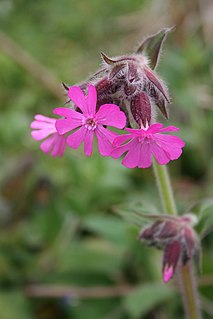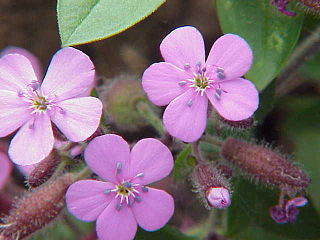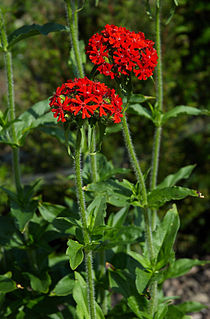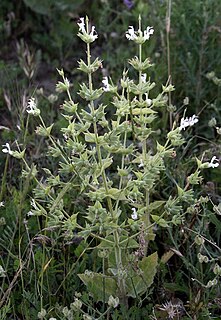
Silene is a genus of flowering plants in the family Caryophyllaceae. Containing nearly 900 species, it is the largest genus in the family. Common names include campion and catchfly. Many Silene species are widely distributed, particularly in the northern hemisphere.

Caryophyllaceae, commonly called the pink family or carnation family, is a family of flowering plants. It is included in the dicotyledon order Caryophyllales in the APG III system, alongside 33 other families, including Amaranthaceae, Cactaceae, and Polygonaceae. It is a large family, with 81 genera and about 2,625 known species.

Saponaria is a genus of flowering plants in the family Caryophyllaceae, native to Asia and Europe, and are commonly known as soapworts. They are herbaceous perennials and annuals, some with woody bases. The flowers are abundant, five-petalled and usually in shades of pink or white. The genus is closely related to Lychnis and Silene, being distinguished from these by having only two styles in the flower. It is also related to Gypsophila, but its calyx is cylindrical rather than bell-shaped.

Silene chalcedonica, the Maltese-cross or scarlet lychnis, is a species of flowering plant in the family Caryophyllaceae, native to central and eastern Russia, Kazakhstan, Mongolia and northwestern China. Other common names include flower of Bristol, Jerusalem cross and nonesuch.

Silene virginica, the fire pink, is a wildflower in the pink family, Caryophyllaceae. It is known for its distinct brilliant red flowers. Each flower is approximately five centimeters in diameter and composed of five notched, brilliant red petals which extend into a long tube. It is a small, short-lived perennial, with lance shaped leaves. Its stems, and the bases of the flowers, are covered in short sticky hairs. Fire pink begins blooming in late spring and continuing throughout the summer. It is sometimes grown in wildflower, shade, and rock gardens.

Silene acaulis, known as moss campion or cushion pink, is a small mountain-dwelling wildflower that is common all over the high arctic and tundra in the higher mountains of Eurasia and North America,. It is an evergreen perennial flowering plant in the carnation family Caryophyllaceae.

Isatis is a genus of flowering plants in the family Brassicaceae, native to the Mediterranean region east to central Asia. The genus includes woad. Due to their extremely variable morphology, the Asian species in particular are difficult to determine; the only reliable diagnostic feature is the ripe fruit. They are (usually) biennial or perennial herbaceous plants, often bluish and hairless or downy hairy with the upright stem branched.

Silene dioica, known as red campion and red catchfly, is a herbaceous flowering plant in the family Caryophyllaceae, native throughout central, western and northern Europe, and locally in southern Europe. It has been introduced in Iceland, Canada, the US, and Argentina.

Silene vulgaris, the bladder campion or maidenstears, is a plant species of the genus Silene of the family Caryophyllaceae. It is native to Europe, where in some parts it is eaten, but is also widespread in North America, where it is a common wildflower in meadows, open woods, and fields.

Aegilops crassa is an ornamental plant in the family Poaceae. It is referred to by the common name Persian goatgrass. It is native to Afghanistan, Iran, Iraq, Kazakhstan, Kyrgyzstan, Lebanon, Palestine, Syria, Tajikistan, Transcaucasia, Turkey, Turkmenistan, and Uzbekistan.
Arenaria nevadensis is a species of flowering plant in the family Caryophyllaceae. It is endemic to Spain. Its natural habitat is Mediterranean Matorral shrubby vegetation. It is threatened by habitat loss.

Salvia macrosiphon is a species of flowering plant in the mint family, Lamiaceae. It is native to Iraq, Iran, Pakistan, Afghanistan, Transcaucasia, and Turkey, where it grows at the edges of fields. It is a perennial herb with a white corolla and ovate nutlets. It flowers in May and fruits from June onwards. Although the plant is similar to S. spinosa, it differs in that it has narrower leaves and calyces, is less indurate and has less spiny fruiting calyces, and possesses a longer corolla tube.
Clypeola elegans is a species of flowering plant in the family Brassicaceae. It is native to Iran, Transcaucasia and Turkey.

Van herbed cheese is a type of cheese made out of sheep's or cow's milk. Ripened cheese varieties containing herbs are traditional in Turkey and have been manufactured for more than 200 years in the east and southeast of the country. They are manufactured from raw milk, semi-hard in texture and salty in taste and have the aroma of garlic or thyme due to added herbs. Twenty-five types of herb, including Allium, Thymus, Silene and Ferula species which are most popular, are used individually or as appropriate mixtures. The most popular of these cheeses is Otlu which is produced mainly in the Van Province of Turkey in small dairies and villages, but now is produced in other cities of the eastern region of Turkey and its popularity increases continuously throughout Turkey.

Silene conica is a species of flowering plant in the family Caryophyllaceae known by the common names striped corn catchfly and sand catchfly. It grows in dunes and sandy soils and is widespread in Europe and western Asia. It has an annual life history and produces self-compatible hermaphroditic flowers and occasional male-sterile flowers. Like other members of Silene section Conoimorpha, S. conica is readily recognizable based on its bright pink petals and the prominent, parallel veins on its calyx. In contrast to most flowering plants, S. conica appears to have a very rapid rate of mitochondrial mutation, and has the largest mitochondrial genome ever identified.
Erodium astragaloides is a species of flowering plant in the geranium family Geraniaceae. It is endemic to Sierra Nevada, southern Spain.
Silene jenisseensis, is a species of flowering plant in the family Caryophyllaceae, native to Siberia, Far East and Mongolia.

Eremogone is a genus of flowering plants in the family Caryophyllaceae, native to western North America, northern Asia, eastern Europe and northeastern Africa. Attempts to resolve taxonomic relationships within the Caryophyllaceae have resulted in the enlargement of Eremogone with species from other genera.

Silene otites, called Spanish catchfly, is a species of flowering plant in the genus Silene, native to Europe and the Transcaucasus area, and introduced to Xinjiang in China. It varies its floral odors to attract mosquitoes and moths at night and flies and bees by day. It is dioecious, with separate male and female plants.















